Natylie Baldwin's Blog
October 13, 2025
US Has Been Supporting Long Range Drone Attacks Inside Russia for Months
By Dave DeCamp, Antiwar.com, 10/12/25
The Trump administration has been providing Ukraine with intelligence to carry out long-range drone attacks against Russian energy infrastructure, the Financial Times reported on Sunday, citing multiple US and Ukrainian officials.
The report said that the US intelligence helps Ukraine “shape route planning, altitude, timing and mission decisions, enabling Ukraine’s long-range, one-way attack drones to evade Russian air defenses.”
A US official told the paper that Ukraine selects the target for the strike, then the US provides information on its vulnerabilities. However, other officials said the US has actually been setting out target priorities for the Ukrainian military, meaning the US is choosing what to strike.
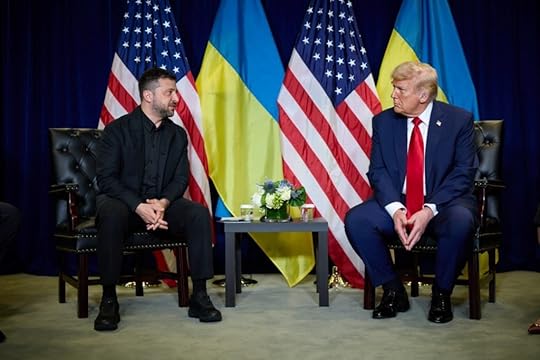 Trump and Zelensky meeting in New York on September 23, 2025 (photo via Zelensky’s office)
Trump and Zelensky meeting in New York on September 23, 2025 (photo via Zelensky’s office)One of the FT’s sources described Ukraine’s drone force as the “instrument” the US is using to achieve the goal of undermining the Russian economy and pushing Russian President Vladimir Putin toward a settlement to end the war. The US has spent billions helping build up Ukraine’s drone program, an effort backed by the CIA.
The report said that the US began supplying Ukraine with the intelligence following a July phone call between President Trump and Ukrainian President Volodymyr Zelensky, during which Trump reportedly asked if Ukraine could hit Moscow if the US provided longer-range weapons. In August and September, Ukrainian drone attacks on Russian energy infrastructure significantly escalated.
US-backed attacks on Russian territory always risk a major escalation between Russia and NATO, and the FT report noted that the Biden administration refrained from supporting such strikes on Russian energy infrastructure. President Biden did support Ukrainian strikes on Russian border regions using ATACMS, US-provided missiles that have a range of about 190 miles.
President Trump reportedly halted the ATACMS strikes, but The Wall Street Journal recently reported that he has now signed off on supporting long-range missile strikes inside Russia. His administration is considering supplying Ukraine with Tomahawk missiles, which are nuclear-capable and have a range of over 1,000 miles, though it remains unclear if it’s a realistic option since the Ukrainian military lacks a way to fire them.
If you liked this article, please support Antiwar.com.
We are 100% reader-supported.
Dave DeCamp is the news editor of Antiwar.com, follow him on Twitter @decampdave.
Geoffrey Roberts: Moscow’s 1954 Proposal that the USSR Join NATO
Putin mentioned in his Valdai speech that in 1954 Moscow proposed Soviet membership of NATO – as part of a package of policies to create an inclusive, pan-European system of collective security.
This brought to mind my publication of the key Soviet archival document on this somewhat surprising suggestion – which was part of Moscow’s campaign to radically curtail the cold war:
https://www.wilsoncenter.org/publication/molotovs-proposal-the-ussr-join-nato-march-1954
~Geoffrey Roberts
Molotov’s Proposal that the USSR Join NATO, March 1954
By Geoffrey Roberts, The Wilson Center, November 21, 2011
CWIHP e-Dossier No. 27
The document below is a translation of V. M. Molotov’s proposal to the Soviet Presidium in March 1954 that the USSR should issue a diplomatic note to the Western powers stating its willingness to consider joining NATO. The background to Molotov’s memorandum was the launch of the Soviet campaign for European collective security at the Berlin Conference of Foreign Ministers in February 1954. At that conference Molotov proposed the Soviet alternative to western plans for a European Defense Community (EDC) involving the participation of a rearmed West Germany—the conclusion of a pan-European collective security treaty. This proposal was linked in tum to a further set of Soviet proposals on the German question, including Germany’s reunification and neutralization in the cold war.
Molotov’s collective security proposal was rejected by western representatives on two grounds. Firstly, because the United States was excluded from the proposed treaty and relegated, together with Communist China, to observer status. Secondly, because the Soviet proposal aimed, it was said, to disrupt NATO as well as halt the formation of the EDC. Molotov responded to these criticisms by saying that the Soviet proposal could be amended and that he was open to persuasion about the value of NATO as a defensive organization.
When Molotov returned to Moscow he tasked Deputy Foreign Minister Andrei Gromyko to formulate proposals on the furtherance of the Soviet collective security campaign. On 10 March Gromyko presented Molotov a draft note for the Presidium proposing that the Soviet position on European collective security should be amended (a) to allow full US participation in the system and (b) the possibility of the USSR joining NATO.[1] Further drafts were presented to Molotov on 20 and 24 March.[2] These drafts were corrected in detail by Molotov. The major change made by Molotov was to delete Gromyko’s statement that the USSR would join NATO on certain conditions and to substitute the formulation that the Soviet Union was prepared to discuss the matter with interested parties. He also added a paragraph stating that the implications of possible Soviet membership of NATO had to be considered even now (see paragraph 9 in the document below). The final version of the note was sent Malenkov and Khrushchev on 26 March, together with the text of the proposed Soviet statement to the Western powers. This text was issued, unaltered, to Britain, France and the United States on 31 March 1954. It announced two amendments to the Soviet draft treaty on European collective security: the United States would not be excluded from formal participation in a system of pan-European collective security and if NATO relinquished its aggressive character the USSR would consider participation in the organization. In those circumstances, concluded the note, NATO “would cease to be a closed military alignment of states and would be open to other European countries which, together with the creation of an effective system of European collective security, would be of cardinal importance for the promotion of universal peace.”[3]
The administrative process through which the Soviet proposal was produced internally was typical of Molotov’s foreign ministry i.e. the production of numerous drafts by his deputies that he personally hand-corrected before they were sent to the Presidium (in the first instance to Khrushchev and Malenkov) for approval. It was unusual, however, for Molotov to present the Presidium with a long, discursive memorandum justifying what was being proposed. Usually, he just sent a short note enclosing the foreign ministry’s proposals which were then discussed in personal conversation at the Presidium level. On this occasion Molotov evidently felt the need for an advance written justification of what was being proposed.
Readers can judge for themselves what the document tells us about the character of the Soviet campaign for European collective security but it seems clear that (a) the reformulation of the Soviet position on 31 March 1954 was designed to further that campaign and (b) that while Molotov thought it unlikely the proposal would succeed (c) he did not rule out the possibility of the USSR joining NATO under certain conditions. It should be noted, too, that while propaganda advantage was an argument the foreign ministry frequently deployed in its submissions to the Presidium that did not mean the proposals were not seriously intended as well.
In May 1954 the Western powers rejected the Soviet proposal to join NATO on grounds that the USSR’s membership of the organization would be incompatible with its democratic and defensive aims. However, Moscow’s extensive and intensive campaign for European collective security continued until the Geneva Foreign Ministers Conference of October-November 1955.[4]
Geoffrey Roberts is Professor and Head of the School of History at University College Cork, Ireland. His latest book is Molotov: Stalin’s Cold Warrior , Potomac Books, 2011.
Footnotes[1] Foreign Policy Archives of the Russian Federation (Arkhiv Vneshnei Politiki Rossiiskoi Federatsii, or AVP RF), F. 6, Op. l3, Pap. 2, D. 9, Ll. 20-25. I am grateful to Alexei Filitov for bringing the existence of this file to my attention.
[2] Ibid., Ll. 34-37, 44-55.
[3] “Note of the Soviet Government… 31 March 1954,” Supplement to New Times, no. 14, 3 April 1954.
[4] For a more in-depth discussion, see Geoffrey Roberts, “A Chance for Peace? The Soviet Campaign to End the Cold War, 1953-1955,” Working Paper No. 57, Cold War International History Project, December 2008.
Document
Source: Foreign Policy Archives of the Russian Federation ( Arkhiv Vneshnei Politiki Rossiiskoi Federatsii, or AVP RF) , F. 6, Op. 13, Pap. 2, D. 9, L1. 56-59. Translated for CWIHP by Geoffrey Roberts.
[Click to view the document in CWIHP’s online Digital Archive]
Presidium, CC CPSUTo: Comrade G.M. Malenkov and Comrade N.S. Khrushchev
According to reports from Soviet embassies and missions and in the foreign press, the Soviet draft of a General European Agreement on Collective Security in Europe has provoked positive responses from quite broad public circles abroad, including such French press organs as Le Monde… At the same time, the Soviet draft has, for understandable reasons, provoked a negative reaction from official circles and from supporters of the “European Defense Community” in France, England and other West European countries. It should be noted that official circles in France have also taken measures to mute the Soviet proposal. Among opponents of the European Defense Community there are also those who don’t support the proposal for a General European Agreement. In this regard the main argument advanced against our proposal is the thesis that the Soviet draft is directed at dislodging the USA from Europe so that the USSR can take its place as the dominating power in Europe. Especially broad use of this thesis is being made in France. Meriting attention in this connection is a conversation between our ambassador in Paris, comrade Vinogradov, and the Gaullist leader [Gaston] Palewski, who said the Soviet proposal is unacceptable in its present form because it excludes the USA from participation in the collective security system in Europe. According to Palewski attitudes to the Soviet proposal would change if the Soviet government declared the USA could take part in the system of collective security in Europe in its capacity as an occupying power in Germany, bearing in mind that the occupation of Germany would not last forever. From this statement of Palewski’s it follows that the USA’s participation in the General European Agreement on a system of collective security would be of a temporary character and limited to the period until the conclusion of a peace treaty with Germany.
The thesis of the dislodgement of the USA from Europe is also being used against the Soviet proposal by supporters of the European Defense Community in England and other countries, by official circles that support the plan for the creation of such a “community” and its so-called European army.
Taking this into account, the Foreign Ministry considers it advisable to limit the possibilities of using this argument against the Soviet draft by sending the governments of the USA, England and France a note which states that on its part the Soviet government sees no obstacle to the positive resolution of the question of the USA’s participation in the General European Agreement on Collective Security in Europe. In the Foreign Ministry’s view it would be inadvisable to declare that the participation of the USA would be of a temporary character. In this regard the Foreign Ministry proceeds from that fact that from the point of view of the interests of the struggle against the European Defense Community it would be inexpedient to indicate the temporary character of the USA’s participation in the General European Agreement.
In introducing a proposal for the participation of the USA in the General European Agreement, the Foreign Ministry considers it advisable not to change the previous proposal that the Chinese People’s Republic would participate in the system of collective security in Europe as an observer
It is necessary to consider another argument deployed against the Soviet proposal, namely that it is directed against the North Atlantic Pact and its liquidation. In order to limit the use of this argument against the Soviet proposal the Foreign Ministry considers it advisable that simultaneously with our proposal about the participation of the USA in the General European Agreement we should, in the same note, pose, in an appropriate form, the question of the possibility of the Soviet Union joining the North Atlantic Pact. Raising this question would make things difficult for the organizers of the North Atlantic bloc and would emphasize its supposedly defensive character, so that it would not be directed against the USSR and the people’s democracies.
The simultaneous posing of the possible participation of the USA in the General European Agreement and possibility of the USSR joining the North Atlantic Pact would be advantageous for us because it would be perceived as demanding a concession in return for the USSR’s agreement on the participation of the USA in the General European Agreement… However, the Foreign Ministry’s view is that our agreement on the admittance of the USA into the General European Agreement should not be conditional on the three western powers agreeing to the USSR joining the North Atlantic Pact.
Most likely, the organizers of the North Atlantic bloc will react negatively to this step of the Soviet government and will advance many different objections. In that event the governments of the three powers will have exposed themselves, once again, as the organizers of a military bloc against other states and it would strengthen the position of social forces conducting a struggle against the formation of the European Defense Community. Such a negative attitude toward the initiative of the Soviet government could, of course, have its negative side for us in so far as it affected the prestige of the Soviet Union. Taking this into account, the Foreign Ministry proposes that the Soviet note should not state directly the readiness of the USSR to join the North Atlantic bloc but limit itself to a declaration of its readiness to examine jointly with other interested parties the question of the participation of the USSR in the North Atlantic bloc.
Of course, if the statement of the Soviet government meets with a positive attitude on the part of the three western powers this would signify a great success for the Soviet Union since the USSR joining the North Atlantic Pact under certain conditions would radically change the character of the pact. The USSR joining the North Atlantic Pact simultaneously with the conclusion of a General European Agreement on Collective Security in Europe would also undermine plans for the creation of the European Defense Community and the remilitarization of West Germany.
The Foreign Ministry considers that raising the question of the USSR joining NATO requires, even now, an examination of the consequences that might arise. Bearing in mind that the North Atlantic Pact is directed against the democratic movement in the capitalist countries, if the question of the USSR joining it became a practical proposition, it would be necessary to raise the issue of all participants in the agreement undertaking a commitment (in the form of a joint declaration, for example) on the inadmissibility of interference in the internal affairs of states and respect for the principles of state independence and sovereignty.
In addition the Soviet Union would, in an appropriate form, have to raise the question of American military bases in Europe and the necessity for states to agree to the reduction of military forces, in accordance with the position that would be created after the USSR’s entry into the North Atlantic Pact.
At the present time, however, it will be sufficient, taking into account the above considerations, to include at the end of the note a statement of a general character: “the Soviet Government keeps in mind that the issues arising in connection with this question must be resolved in the interests of strengthening world peace and the security of peoples.”
The draft resolution for the CC of the CPSU is enclosed
I ask you to examine it.
V.M. Molotov26 March 1954
[Click to view the document in CWIHP’s online Digital Archive]
October 12, 2025
Andrew Korybko: Was Scandinavia’s Russian Drone Scare A False Flag To Crack Down On Russia’s Shadow Fleet?
By Andrew Korybko, Substack, 9/30/25
Unknown drones recently flew in close proximity to Danish and Norwegian airports, prompting speculation among some that they were Russia’s delayed hybrid retaliation against NATO for backing Ukraine’s drone flights in proximity to Russia’s own airports over the past few years. No evidence has emerged in support of that hypothesis, but Zelensky still dishonestly passed off such claims as fact during his speech at the latest Warsaw Security Forum.
According to him, “there is growing evidence that Russia may have used tankers in the Baltic Sea to launch drones – the drones that caused major disruption in Northern Europe. If tankers used by Russia are serving as drone platforms, then such tankers should not be free to operate in the Baltic. This is de facto Russia’s military activity against European countries, so Europe has the right to close straits and sea routes to protect itself.”
His proposal for NATO to close the Danish Staits to Russian shipping on this pretext, which would amount to an illegal blockade that could thus legitimize offensive action by Russia in self-defense, was predictable given Ukraine’s and some of its patrons’ interest in escalating the bloc’s tensions with Russia. In fact, it might even be the case that this was the false flag that Russia’s Foreign Intelligence Service twice warned could soon be staged by the UK and Ukraine, albeit ultimately taking a different form.
They assessed that those two might orchestrate potentially forthcoming provocations in the Baltic that would then be blamed on Russia in order to justify cracking down on its sanctioned energy trade that the West dramatically describes as being conducted by a “shadow fleet” transiting through that sea. While no US ship was targeted with Ukrainian-transferred Soviet/Russian torpedoes nor were such mines fished out of the Baltic, Scandinavia’s Russian drone scare still arguably fulfills the same role.
Skeptics might insist that Russia resorted to “plausibly deniable hybrid retaliation” against NATO, yet it’s illogical that Russia would risk anything that could justify the same escalation that Putin’s restraint has thus far avoided, the same goes for the earlier drone incident in Poland. Ditto that for the associated accusation that it violated Estonia’s maritime airspace. All these incidents were spun by the West as deliberate Russian provocations and preceded escalatory proposals misportrayed as “retaliation”.
The Polish and Estonian ones were exploited to get Trump to greenlight NATO downing Russian jets on the basis of them violating the bloc’s airspace, which might embolden some to attempt this on false pretexts, while the Scandinavian ones were exploited to call for closing the Danish Straits to its shipping. Both concern escalations in the Baltic, which could amount to an illegal blockade that obstructs the free movement of Russian planes and ships there, thus also placing unprecedented pressure on Kaliningrad.
This insight strongly suggests that Scandinavia’s Russian drone scare was indeed a false flag to justify cracking down on Russia’s “shadow fleet”, though it’s presently unclear whether any NATO members will cross the Rubicon by seriously making any such move like closing the Danish Straits to its shipping. In any case, Zelensky’s proposal proves that he’s trying to manipulate Trump into a disaster of epic proportions together with some of his like-minded NATO patrons, but hopefully Trump won’t fall for it.
October 11, 2025
Riley Waggaman: The SMO has achieved everything it was supposed to prevent in Ukraine
Riley Waggaman, Substack, 10/3/25
Riley Waggaman used to be a contributor and editor at RT. He lives in Russia.
On December 17, 2021, Moscow issued a list of security demands to NATO. The document stipulated that:
“The Participants [ the RF and NATO members ] undertake not to create conditions or situations that might represent or be regarded as a threat to the national security of the other Participants.”“The Participants exclude the deployment of medium- and shorter-range ground-based missiles in areas from which they are capable of hitting targets on the territory of other Participants.”“The Participants that are member states of the North Atlantic Treaty Organization shall make commitments that exclude further NATO expansion, including the accession of Ukraine, as well as other states.”“The Participants that are members of the North Atlantic Treaty Organization undertake to not conduct any military activity on the territory of Ukraine, as well as other states of Eastern Europe, Transcaucasia, and Central Asia.”Four days later, at a meeting with the Defense Ministry, Russian president Vladimir Putin said Moscow was prepared to take action to protect its key security interests and prevent US missile systems, which had been inching closer and closer to Russia’s borders, from being deployed to Ukraine:
If this infrastructure moves further, if US and NATO missiles appear in Ukraine, their flight time to Moscow will be reduced to 7-10 minutes, and for hypersonic weapons no more than five. For us, this represents a most serious challenge to our security.
[…]
We have issued a proposal that would rule out further NATO expansion in an easterly direction, as well as the deployment of offensive weaponry in countries adjacent to us … We need long-term, legally binding guarantees.
[…]
In the case of the continuation of the clearly aggressive line of our Western colleagues, we will take adequate retaliatory military-technical measures, responding to unfriendly steps.
As promised, Russia took military-technical measures after NATO rejected the treaty.
In his February 24, 2022 address announcing the start of the Special Military Operation in Ukraine, Putin explained that “[NATO’s] military presence in territories bordering on Russia, if we permit it to go ahead, will continue for decades to come, or maybe forever, creating an ever-mounting and totally unacceptable threat for Russia.” Military intervention was necessary in order to deter NATO from further eastward expansion, which would represent an existential threat to Moscow:
We cannot stay idle and passively observe these developments. This would be an absolutely irresponsible thing to do for us.
[…]
I reiterate: We are acting to defend ourselves from the threats created for us and from a worse peril than what is happening now.
Putin ended his address by promising that Russia would “respond immediately” to any outside attempts to interfere with the SMO. Any state or foreign actor caught trying to hinder Moscow from protecting its legitimate security interests in Ukraine would “face consequences … such as you have never seen in your entire history.”
In the nearly four years that have passed since Putin made these remarks, NATO has added two new members and turned Ukraine into a base of operations for daily attacks on Russian territory. The weapons used to carry out these attacks have been steadily increasing in range and lethality. Last month, Kiev received authorization from Washington to use US long-range missiles to strike targets deep inside Russia.
Commenting on these developments at the Valdai Discussion Club in Sochi on Thursday, Putin said he was tempted to give Finland a very rude hand gesture for joining NATO, but did not want to offend the women in the audience.
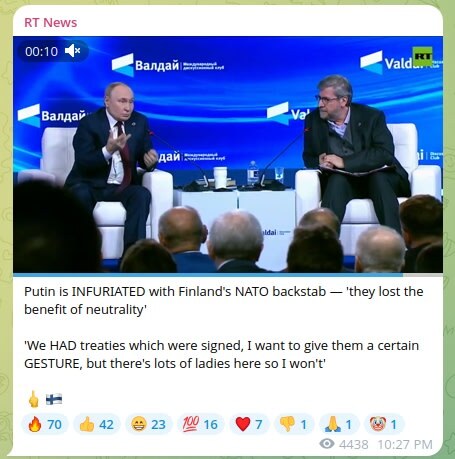 source: RT (https://t.me/rtnews/114292)
source: RT (https://t.me/rtnews/114292)He was similarly displeased about Kiev receiving approval from Washington to use US missiles, manned by US specialists, to attack Russia from Ukrainian territory. Such attacks would be perceived by Moscow as “a new stage of escalation” that would harm US-Russia relations.
“Would [US military specialists using long-range missiles deployed to Ukraine to strike targets deep inside Russia] pose damage to our relations, where we see light at the end of the tunnel? Of course,” Putin said.
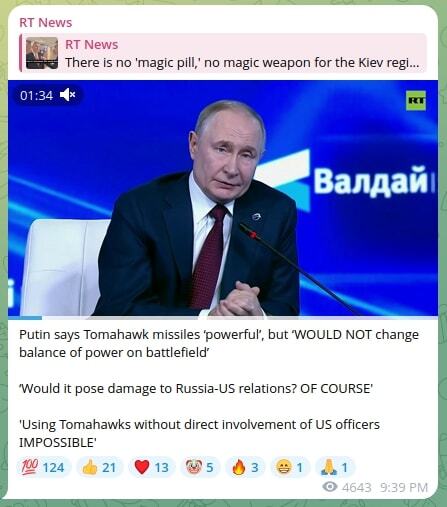 Source: RT (https://t.me/rtnews/114280)
Source: RT (https://t.me/rtnews/114280)Who could have imagined that Putin would be making such statements more than three and a half years after announcing the start of the SMO, promising historic consequences for anyone who intervened on the side of Ukraine? As it turns out, Russia’s prestigious Valdai Club—the same international forum that Putin spoke at yesterday—predicted this exact scenario.
In an article published in November 2021, three months before the launch of the SMO, Ivan Timofeev, program director for the Valdai Club, explored the probable outcomes of Russian military intervention in Ukraine.
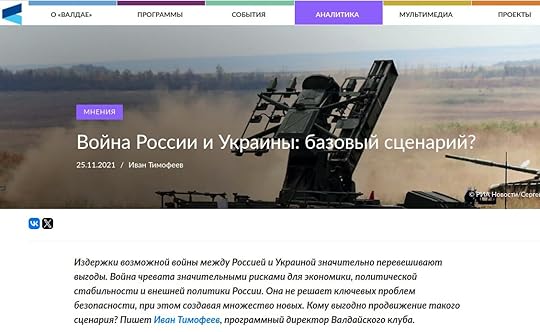 Source: valdaiclub.com
Source: valdaiclub.comTimofeev imagined a scenario in which Russian forces would strike Ukraine in several directions at once. With the help of uncontested air superiority, the Russian military would either encircle Ukrainian troops in the East, or force them to withdraw to Western Ukraine. Kiev would be declared the capital of a Russia-backed Ukraine, which would include the fully liberated Donbass:
The new state would be recognized by Russia … solving several historical problems at once. An immediate threat to the southwestern borders would be removed. Full control over the Sea of Azov and the land corridor to the Republic of Crimea would be ensured. Two Ukrainian states would appear on the map, one of which is “friendly and fraternal”.
A variation of this scenario involved taking full control of Ukraine, although Timofeev believed this would lead to a prolonged insurgency by Ukrainian nationalists.
Ultimately, Valdai’s program director concluded that military intervention in Ukraine would not resolve Moscow’s core security issues. Instead, a military operation aimed at deterring further NATO aggression would likely exacerbate preexisting problems:
Such a military conflict is unlikely to be ended by any clear agreement. Victory over the Ukrainian military will not lead to a quick peace. The war could develop into a long and sluggish confrontation, especially if part of the territory (for example, Western Ukraine) remains under the control of the Ukrainian military.
[T]he conflict will inevitably lead to a sharp change in the approach to providing Ukraine with modern models of weapons and military equipment. In the United States and in the West as a whole, the new situation will be considered an emergency, and all possible means will be used to equip the Ukrainian military. In this case, all possible conventional weapons will be supplied. Large-scale military aid of the West will drag out the conflict. […]
In other words, the costs of a possible war significantly outweigh the benefits … [A war] would not solve key security problems, while creating many new ones.
Unfortunately, Timofeev’s pessimistic assessment was far too optimistic.
Russia is not battling an insurgency in Lvov. After nearly four years of war, the Russian military is fighting for control of Pokrovsk, a town located in Donetsk Oblast. Assuming Pokrovsk is eventually taken, the Russian military will then have to turn its attention to Ukraine’s major strongholds in Donbass: Kramatorsk, Sloviansk, Druzhkivka, and Kostiantynivka. Then it will be necessary to capture Zaporozhye and Kherson, capitals of Russian regions currently occupied by the Ukrainian Armed Forces. Then there is Kharkov. Then ….
In other words, there’s considerable work to be done if Moscow hopes to achieve, at the bare minimum, the worst case scenario in Ukraine as outlined by the Valdai Club.
October 10, 2025
Moon of Alabama: Ukrainian Media About Gaps In The Frontline And Other Failures
Moon of Alabama, 10/8/25
The Ukrainian news-outlet Ukrainska Pravda has a new report about the state of the Ukrainian forces at the frontline. The Russian forces are winning the war bit by bit while the Ukrainian army is in constant retreat. The report is discussing several issues which prevent the Ukrainians from holding the line.
While most of UP’s pieces are published in Russian/Ukrainian and English this one has yet to receive a translation. Below summaries and excerpts of it (edited machine translation):
The holes between the infantry positions are getting bigger and bigger.
What prevents the Ukrainian army from deterring the Russians – Ukrainska Pravda, Oct 6 2025
The most urgent need directly on the front line remains infantry. At the current stage of the war, when the work of heavy equipment is maximally complicated, the role of soldiers in the trenches increases significantly. When they are not enough, it is not easy to organize a defense.
Due to the lack of people, many units cannot hold their positions, fully repel Russian attacks, adequately rest and conduct the necessary rotation. As a result, field commanders are forced to choose priority areas, leaving other sectors less protected.
In consequence there is no longer a real frontline. The lack of infantry leads to gaps through which Russian forces can slip into the rear of the Ukrainian forces. Ukrainian mortar troops and drone pilots who are nominally stationed five kilometer behind the frontline suddenly find themselves in direct contact with enemy troops:
A consequence of the problem described above is that infantry positions are increasingly literally deserted. Therefore, the distance between neighboring positions can be 200-300 –, 500-700 –meters, and sometimes even a kilometer.
…
The formation of a huge number of holes between Ukrainian infantry positions and the penetration of these holes by the Russians deep into our defenses has formed another trend of the current stage of the war – the lack of a stable line of engagement.
…
Due to the lack of fighters on the first line, drone and mortar operators, who stand 3-5 kilometers from the front edge, are forced to become infantry.
…
In the worst cases, which UP is also aware of, the Russians even reach artillery positions. These are 10-15 kilometers from the contact line.
Over the last six month the Ukrainian army has changed its structure. Previously various brigades were attached to temporary operational commands (TUS,Tgrs) with each responsible for large parts of the frontline. The new model is based on a corp structure with several brigades assigned to a corp to serve under one permanent command. While the restructuring is officially finished most troops have yet to find their new home:
The key advantage of the transition of the Defense Forces to the corps system was called by supporters of the reform the emergence of stable management bodies. But this is exactly what has not happened so far, because there are still temporary TUS, Tgrs, etc. on the ground in one form or another.
Moreover, there are also questions about the transition to the implementation of tasks by corps exclusively in the designated areas of responsibility. In many sectors of the front, a full-fledged transition did not take place, while the General Staff already has plans to create even new structures, such as assault troops and troops of unmanned air defense systems as part of the air force.
In the context of a general shortage of personnel with the incomplete transition to the corps system, finding resources for new military formations will be quite problematic.
Despite having the just introduced a corp structure the newly created assault battalions were put under direct command of the Ukrainian commander-in-chief, General Syrski. Events in Ukraine recently took a look at those:
Undeterred by the total collapse of the Kursk operation in the spring of 2025, Syrsky remains fixated on the need for new offensives.
Now, the head of the army has created his own personal guard, totally willing to implement all his orders – the assault forces. The western-funded nationalist press has attacked Syrsky’s new project as ‘catastrophic’, claiming that the units involved have taken massive losses in the urge to demonstrate their loyalty to the commander-in-chief.
For whatever reason, these highly critical articles on the assault forces from the likes of BBC Ukraine and texty.org haven’t been translated to English.
Today we’ll take a look at what exactly these new assault forces are. It turns out that they are largely composed of units commanded by the fascist ‘Right Sector’. Syrsky chose these units because they unflinchingly took part in his Kursk adventure – in contrast to other commanders, who criticized Syrsky’s folly and were sacked as a result. …
The best general the Russians have, as Syrski is called by his critics, is also accused of micromanaging the fight at the frontline (edited machine translation):
In June 2025, Ukrayinska Pravda was the first to write about how Commander-in-Chief Alexander Syrsky resorted to manual control of the front. Independently selects, and already removes, the corps commanders, decides which brigade and how much replenishment is being made, sets tasks for battalions, when they should be assigned by the brigade commander, and so on.
During these three months, the situation with the dependence of the front on the instructions of one person, according to the observations of Ukrayinska Pravda and the UP’s interlocutors in the Defense Forces, has only become more complicated.
At first, Syrsky began to regularly visit and “taxi” the actions of units on the Dobropolsky ledge, which is now being “cut off” by the defense forces. According to public references of the commander-in-chief himself, over the past 3.5 months, he went to meetings and meetings with local commanders as many as eight times.
The introduction of long range First-Person-View drones by Russia has cleared the typical rear of the frontline. Command and logistics had to move back further which makes their work more costly and ineffective:
Due to the activity of Russian aircraft and drones from about the end of spring – and early summer of this year, the support units of the Ukrainian army began to move away from the line-of-contact.
…
According to the decision of the Supreme Chief, all support units had to move 40-50 kilometers away from the contact line.
For logistics commanders, this decision means that with already limited resources – especially fuel-the logistics arm becomes longer and more complex.
“I used to spend 40 liters and a couple of hours to get a few tons of fuel. Now – 300 liters and almost a day,” – shares with UP one of the commanders of support.
The UP authors are pessimistic about possible changes:
[T]he military command at various levels turns a blind eye to fairly obvious problems within the Ukrainian army, and the presidential office, without which no solution in this country is complete, does not risk its ratings [..]
Meanwhile, the gaps between the infantry positions are getting bigger.
Ukraine Promotes Neo-Nazi to Brigadier General
By Kyle Anzalone, Libertarian Institute, 10/2/25
Ukrainian President Volodymyr Zelensky promoted Colonel Andriy Biletsky to the rank of Brigadier General. Biletsky has said the purpose of the Ukrainian right is to fight the “Semitic-led untermenschen [subhumans].”
“To confer the military rank of brigadier general on Colonel Andriy Yevhenovych Biletsky, commander of the 3rd Army Corps of the ‘East’ Operational Command of the Ground Forces of the Armed Forces of Ukraine,” the presidential decree signed Wednesday said.
Biletsky is the commander of the Third Separate Assault Brigade and the founder of the Azov regiment. He is an outright white supremacist. “Ukrainians are part (and one of the largest and highest quality) of the European White Race. Ras-Creator of great civilization, the highest human achievements. The historical mission of our Nation, in this turning point, to lead and lead the White peoples of the whole world into the last crusade for its existence against the Semitic-led untermenschen,” he said in a 2007 speech.
The Third Separate Assadly Brigade webpage says it maintains “the same principles on which the legendary ‘Azov’ and the entire Azov movement are based. The foundation worldview principles of the Azovian units are Ukrainian-centrism, traditionalism, hierarchy and responsibility.”
Additionally, Zelensky awarded the Hero of Ukraine posthumously to Andriy Parubiy. Parubiy was assassinated in August. In 1991, he founded the Social-National Party of Ukraine that used the Nazi Wolfsangel as its logo.
Neo-Nazis, like Biletsky and Parubiy, gained power in Ukraine following the US-backed coup in 2014. Following the ouster of President Viktor Yanukovych, Parubiy rose to the position of speaker of the Parliament, and Biletsky founded the Azov Battalion.
October 9, 2025
Debunking the Myth of Russia’s 3 Day Victory in Ukraine
Russia Truth, 10/1/25
The idea that Russia would defeat Ukraine in only three days—the so-called “three-day SMO”—has become a pervasive meme associated with the war. It’s a widespread misconception, but its origin is not in an official Russian statement.
To understand where this notion came from, we can look back to 2014, when an article reported Vladimir Putin boasting he could take Kyiv in two weeks. Considering the poor state of the Ukrainian army then, with mass defections in Crimea and struggles against separatist militias, this claim was perhaps plausible at the time.
The Russian Media and Cyber War Angle
The story picked up again in April 2021 when RT’s editor-in-chief, Margarita Simonyan, stated in an interview that Russia would defeat Ukraine in two days in the event of a “hot war.” Crucially, she said this in the context of a cyber war that would target infrastructure, causing city blackouts and cutting gas supplies, not a conventional ground war. She even expressed skepticism about a conventional war being possible in the modern world.
Western Intelligence and Historical Precedents
When the February 2022 invasion began, many Western officials genuinely expected a swift conclusion. This expectation was informed by the quickness of previous Russian actions, such as the annexation of Crimea in 2014 and the 2008 invasion of Georgia, where the bulk of the fighting lasted only about five days.
The Royal United Services Institute (RUSI) Report
A specific source for the “72 hours” claim appears on the Ukrainian version of the Wikipedia page for the Battle of Kyiv. It cited the Royal United Services Institute (RUSI), which allegedly stated that Russian forces intended to capture and blockade Kyiv within 72 hours. Notably, this refers to blockading Kyiv, not invading the entire country.
However, a closer look at the RUSI report, “Preliminary Lessons in Conventional War Fighting from Russia’s invasion of Ukraine February to July 2022,” presents a different timeline, stating that Russia planned to invade Ukraine over a 10-day period and occupy the country to enable annexation by August 2022. The report based much of its information on captured Russian documents, but stated the underlying source material could not be made public, which raises a significant red flag. Furthermore, those alleged documents from the 810th Russian Naval Infantry Brigade reportedly gave a 15-day timeline for seizing objectives like Melitopol, which was actually captured faster than that supposed expectation. Nowhere in these documents is a 72-hour national takeover mentioned.
The True Origin: US Officials
The reality is that the myth primarily originated from US sources. As Russia’s military buildup became undeniable in early 2022, on February 5, 2022, Fox News reported on a closed-door briefing where General Mark Milley, then Chairman of the Joint Chiefs of Staff, allegedly told US lawmakers that a full-scale Russian invasion could result in the fall of Kyiv within 72 hours. He also predicted substantial casualties. Even Belarusian President Alexander Lukashenko repeated a similar three-to-four-day timeframe for an entire war.
On the day of the invasion, February 24, 2022, Newsweek cited three US officials who expected Kyiv to fall within 96 hours and the Ukrainian leadership to follow in about a week. This is where the myth of the “3-day SMO” was born.
Newsweek itself later admitted that the story provided “ammunition for a decisively misleading meme” and that virtually no prominent Kremlin pundits were predicting the three-day fall. Reddit users have also admitted that the story was a simplification used to ridicule the expectation of a swift Russian victory. While Russia’s high command was almost certainly expecting a rapid victory to force negotiations and concessions, the specific three-day claim was not a Russian one; it was a foreign one that has been widely popularized as a meme.
October 8, 2025
Glen Diesen Interviews Mike Benz on How NGOs and the CIA Hijacked Ukraine
A great discussion on how the CIA-NGO complex started and how it works.
YouTube link here.
October 7, 2025
Paul Robinson: Visit to the Victims of Communism Museum
By Paul Robinson, Website, 9/28/25
A while back, I was in Washington DC, and I visited the new Victims of Communism museum. My interest in this was piqued by the saga of the Victims of Communism monument here in Ottawa, which caused a scandal once it became known that many of the names people had paid to have inscribed on the monument were those of Nazi collaborators. I thought it would be interesting to see how the US museum compared.
I’m pleased to say that it’s not anything like the Ottawa monument. On the whole it does a decent job. That said, the historian in me did find a few claims in the museum that I questioned, and there was, I feel, a certain national bias that popped up here and there, largely in the form of Polish nationalism and in a tendency to portray Russian and Chinese people solely as perpetrators of communist atrocities and not as victims. This despite the fact that probably more Russian and Chinese people have perished as a result of communism than people of any other nationalities.
So let’s take a look. I will focus on the Soviet-related materials, not on those relating to China and elsewhere, as the former are more my area of expertise.
The museum is fairly small. It is conveniently located in downtown Washington and has the advantage of being free of charge. The staff were friendly, and on the day I went, there were not many people there.
The museum has three parts: a permanent exhibition on the ground floor that walks you through the history of communism; a display of paintings by a former Soviet Gulag prisoner; and while I was there, what seemed to be a temporary exhibition on the second floor about Vietnam. I’ll concentrate on the first of these parts.
As you start your tour, you see the following. This pretty much sets the tone for what follows: a lot of big red panels with historical descriptions and photos, but relatively few exhibits.
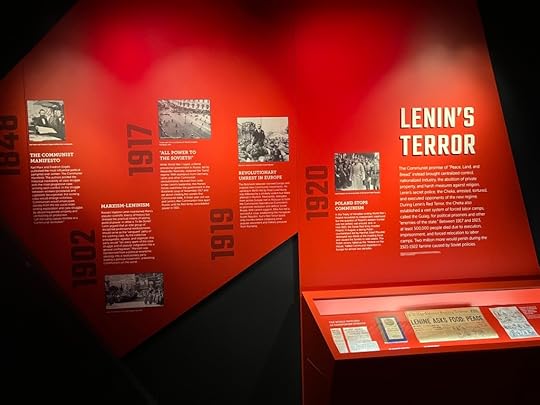
The general descriptions are fine, but I did have a slight quibble with the display below which says that a Provisional Government ‘led by Alexander Kerensky replaced the Tsarist regime.’ This isn’t strictly true, as the government that replaced the Tsarist regime was initially led by Prince G.E. Lvov and Kerensky only took over a few months later. So Kerensky didn’t replace the Tsar but replaced Lvov. It’s a very minor point, but I think that one should aim for 100% accuracy.
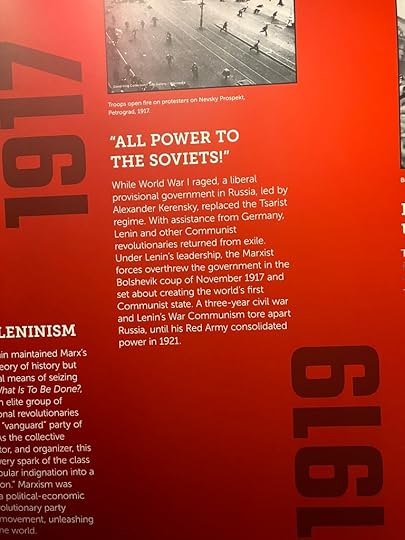
I had a slightly more serious quibble with this display which says that the ‘Soviet Red Army invaded Poland.’ This indeed it did, but not until after the Polish army invaded Soviet territory. This display would probably make most readers think that the Soviets started the Polish-Soviet war by launching an unprovoked attack on Poland, which isn’t entirely accurate.
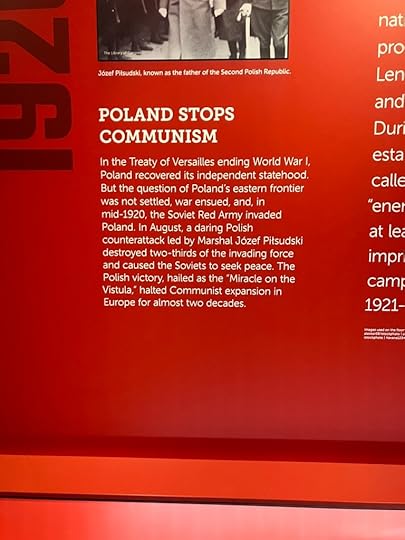
Poles pop up again in this discussion of the Great Terror. On the one hand, the museum has done a good job in not exaggerating the scope of the terror. Indeed, the quoted number of deaths – 700,000 – is on the lower end of what current scholars believe the death toll to have been. I was struck, though, by the claim that nearly a third of victims of the Great Terror (200,000 people) were Poles. It is indeed true that Poles were disproportionately targeted during the Terror. But the number more normally cited is around 120,000. I think that the museum should probably stick with the numbers that are most commonly recognized.
Likewise, there seems to be exaggeration in this display that claims that 70% of the population of Kazakhstan died in the famine of 1932-33. Sarah Cameron, author of a widely-acclaimed book on the topic, puts the total at about one-third of the population. Again, that’s terrible enough, but it’s also far removed from 70%. I don’t know where the museum got that number from and it may need revisiting.
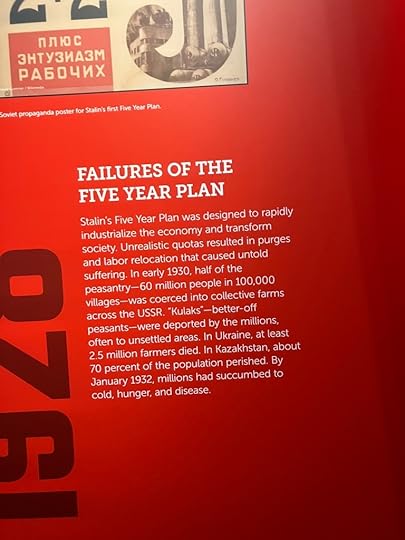
And there’s this panel, which gives a long list of nationalities whose members were ‘sent to the Gulag or other forced settlement areas of the USSR’. Russians are notably absent from the list, though of course very many of them were sent to the Gulag too. Now, it’s true that Russians were not targeted for deportation in toto in the manner of Crimean Tatars or Chechens, but neither were many of the other nationalities mentioned here. Soviet nationality policy also can’t be reduced to efforts ‘to destroy culture and impose conformity’. The Soviets invested a lot of resources into supporting minority languages (in some cases, creating alphabets and providing the first ever schools and literature in that language). Periods of Russification alternated with periods of ‘indigenization’, in which minority cultures were actively promoted and members of minorities given preference in their own republics. Soviet nationalities policy was much more complex than shown here.
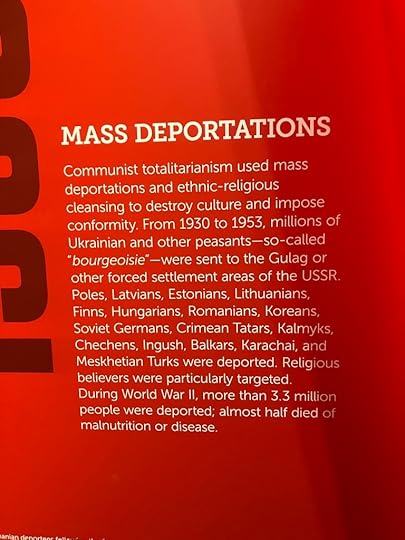
Then we come to a bit of historical revisionism about the start of the Second World War:
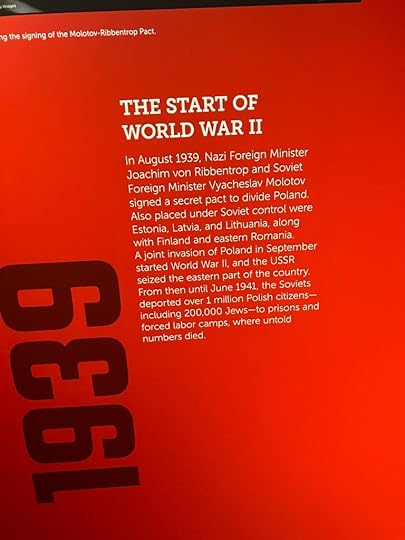
To my mind, it’s not accurate to say ‘a joint invasion of Poland in September [1939] started World War II.’ The British and French declared war on Germany on 3 September. The Soviets didn’t enter Poland until 17 September, two weeks later. Now, it’s true that they were already committed to doing so before then, but the British and French didn’t respond to a ‘joint invasion’ of Poland, but to a German one.
Then, we come to the naming of Russians, as in the two panels below. The first is a quote from a Hungarian priest calling for ‘Russian troops’ to leave Hungary in 1956. The second is a mention of the ‘Russian’ army leaving the Baltic states in 1994. The two panels are entirely accurate. But it strikes me that the language used could serve to conflate the Soviet Union and Russia in the mind of any visitor who didn’t know the subject well. It thus reinforces the idea of Russians as perpetrators not as victims.
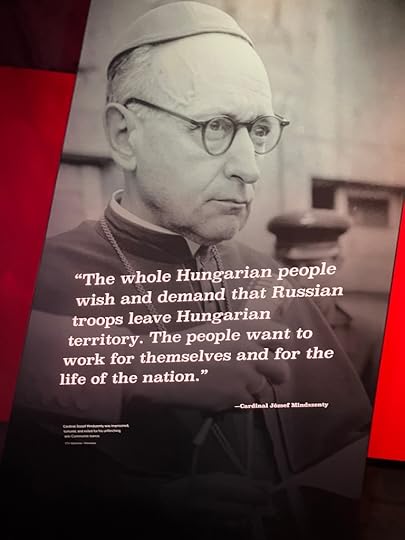
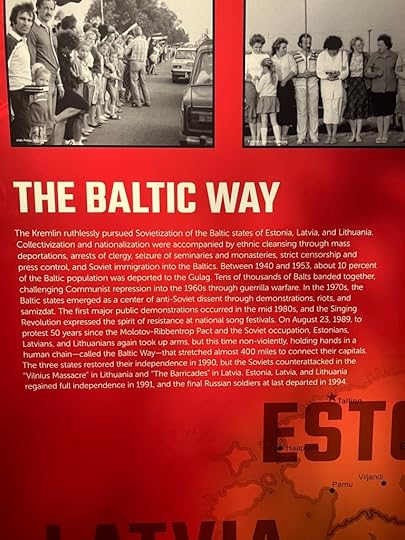
Overall, I would say that it is an interesting place to visit and a younger generation of visitors who know nothing about communism will learn much from it. That said, I have my doubts about museums and monuments focusing entirely on the victims of communism. This isn’t because I am remotely sympathetic to communist theory or practice. Far from it. It’s very correct that people should be reminded of the horrific crimes committed by communist regimes (as they should be of the crimes committed by regimes of other types). But when all you look at is that, it becomes very hard to explain things such as modern-day Soviet nostalgia. It also makes one wonder why on earth anybody would have supported such an ideology. Thus, while the Museum of the Victims of Communism will teach you an important part of the history of communism, one should bear in mind that it is indeed only a part.



